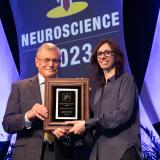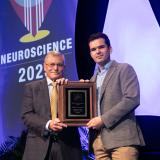2023 Gruber Neuroscience Prize
Huda Akil, Ph.D., of the Michigan Neuroscience Institute at the University of Michigan, has made pioneering contributions to understanding the molecular, neural, and behavioral mechanisms of pain, stress, depression and substance abuse. This includes the discovery that the brain has its own opioid system for blocking pain via the endorphins, and a natural way of modulating depression and anxiety via a growth factor, FGF2. These and other discoveries have led to a new understanding of pain, stress, and substance abuse and offered insight into mechanisms that affect the risk for depression.
2023 Neuroscience Prize Recipient
Laureate Profile
For Huda Akil, Ph.D., her life’s work has been about understanding the biology of emotion. “What makes you feel bad, and what are the mechanisms in the brain that counter these feelings?” Akil said. “Understanding this has been my life’s work.” This included the discovery that the brain had a natural way to block pain. This was the first physiological evidence for the presence of endorphins in the brain and their potential role in pain, stress, addiction and affective behavior.
As a graduate student at UCLA under the mentorship of Dr. John Liebeskind, Akil and colleagues were mapping the regions of the brain responsible for sensing pain, and discovered that certain regions, when stimulated, could block the sensation of pain, a phenomenon they termed stimulation-produced analgesia. The idea that the brain had an active mechanism for blocking pain sensations was very new at the time. “We primarily thought of the body as being able to feel pain, but we had no real understanding of how it minimizes or terminates pain,” Akil said.
Akil‘s early studies showed that the brain blocked pain not by jamming up its transmission but through active mechanisms that countered it. Importantly, the brain regions that supported stimulation-produced analgesia overlapped with brain regions where morphine injection also diminished pain, and the opiate antagonist, naloxone, prevented the brain stimulation from effectively shutting down the pain. This led her and her mentor, Dr. John Liebeskind, to the idea that the brain was producing an opiate-like molecule that could block pain. “That was the first physiological evidence that the brain has a pain inhibitory system with an opiate-like mechanism that is central to it,” Akil said. This preceded the isolation of the first endorphins and the demonstration of opiate receptor binding sites in the brain. Akil went on to collaborate with a neurosurgeon, Dr. Donald Richardson, to demonstrate that deep brain stimulation could reverse pain in humans suffering from intractable pain that was no longer responsive to standard treatments.
For her postdoctoral work, Dr. Akil joined the laboratory of Dr. Jack Barchas at Stanford University, where she continued her research on endorphins and their role in pain and emotions. This included demonstrating the phenomenon of stress-induced analgesia, a process whereby the brain uses the natural pain inhibitory system to block pain during times of stress. “When you are under stress, you need to run, you need to fight, you need to survive,” Akil said. “This is not the time to feel the pain.” Both opioid and non-opioid mechanisms have since been shown to be engaged during acute stress to control the timing and magnitude of the pain response.
As part of this research, Akil examined the role opiates play in the brain, affecting pain pathways in a way that leads to tolerance and dependence. “Opiates can minimize psychological pain,” Akil said. “The worse you feel beforehand, the greater the impact of opioids, which means that people who are in either physical or emotional pain are highly sensitive to them.” However, chronic exposure leads to tolerance and dependence, which affects the normal functioning of the brain. “Brain circuits that produce opioids come to rely on external opiates instead,” Akil said. “The decreased activity of the brain’s own endorphin system leads to the painful physical and psychological symptoms of withdrawal and the need to continue to use drugs”.
Akil’s interest in brain biology of stress and emotion has led her to an interest in the genetic and brain mechanisms that lead to depression. She was one of the founding members of the Pritzker Consortium which used postmortem human brains to discover molecular changes associated with severe depression. They discovered the Fibroblast Growth Factor family (FGF) was altered in the brains of individuals who had been depressed relative to people with no psychiatric history. In particular, FGF2 was reduced in depressed brains. “FGF2 is our own natural antidepressant,” Akil said. Indeed, her laboratory showed in follow-up animal studies that FGF2 can block anxiety and depression-like behaviors and that natural levels of FGF2 in brain inhibit anxiety. Moreover, an enriched environment especially during early development induces higher levels of FGF2 and enhances the ability of the brain to remodel itself (neuroplasticity). This discovery underscores the importance of early environmental conditions in offering a protective benefit against depression later in life.
Akil is collaborating actively with other leading investigators in the Pritzker Consortium and the Hope for Depression Research Foundation to understand the genetic, neural and environmental mechanisms that can be harnessed to induce resilience and protect against depression and other stress-related brain disorders.
Citation
The Gruber Foundation proudly presents the 2023 Gruber Neuroscience Prize to Huda Akil for major contributions to the identification of the neural circuitry and molecular mechanisms that underlie a wide range of neuropsychiatric conditions such as stress, pain, depression, and drug addiction.
Akil was the first to provide experimental evidence supporting the existence of endogenous opioids and their roles, together with their receptors, in regulating pain and stress. She also initiated studies on the molecular underpinnings of mood disorders by identifying the involvement of fibroblast growth factor family members in depression. Her work on rodent models of mental disorders has been validated in translational studies defining genome-wide expression profiles in postmortem human brains.
In addition to scientific contributions that have transformed the field of the neurobiology of mental diseases, Akil has made many generous contributions to the neuroscience community, including mentoring future generations and illustrating the importance of socio-cultural transitions experienced by immigrants in the scientific community.
































































